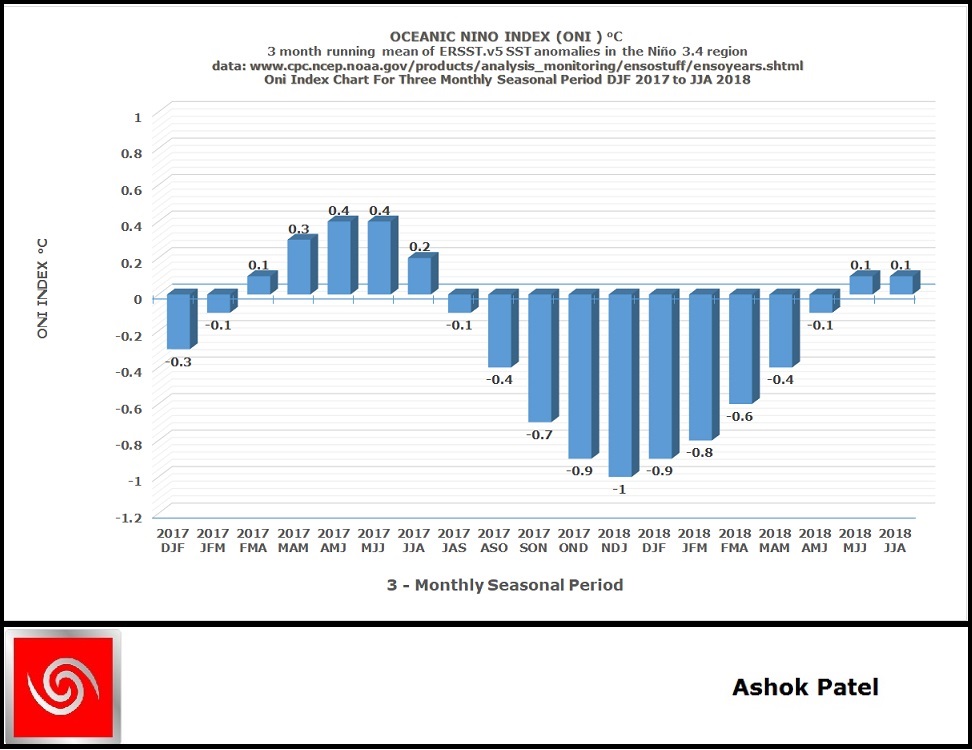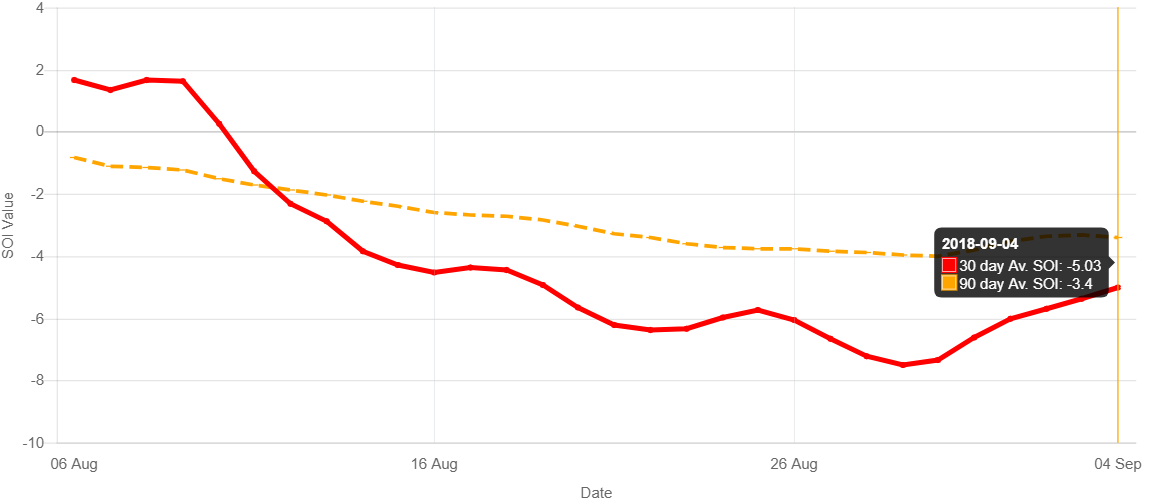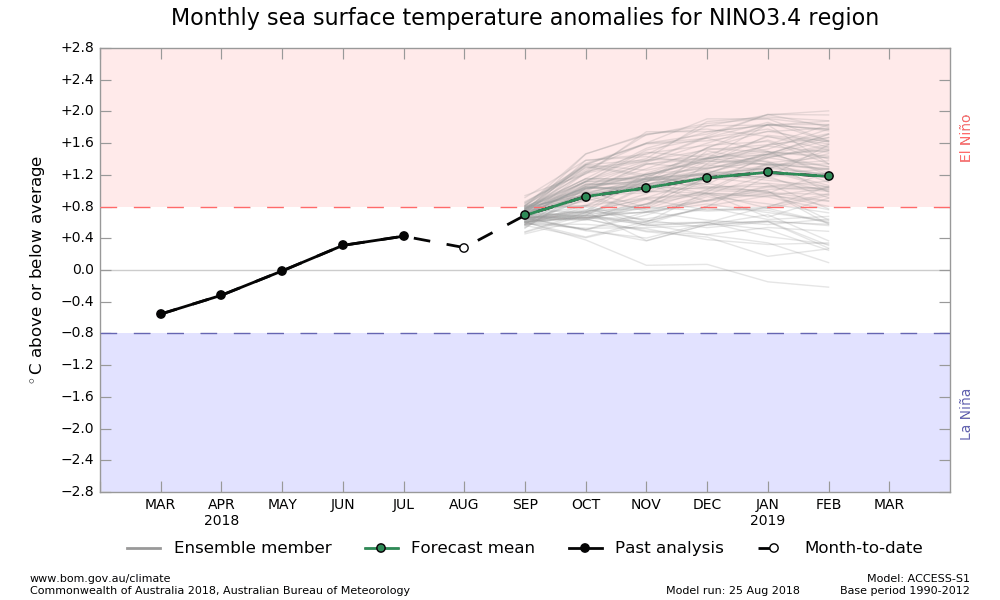Enso Status on 5th September 2018
Enso Neutral Conditions Prevails August 2018
How ONI is determined:
The ONI is based on SST departures from average in the Niño 3.4 region, and is a principal measure for monitoring, assessing, and predicting ENSO. Defined as the three-month running-mean SST departures in the Niño 3.4 region. Departures are based on a set of further improved homogeneous historical SST analyses (Extended Reconstructed SST – ERSST.v5). Explanation about ERSST.v5 is given here.
The SST reconstruction methodology is described in Huang et al., 2015, J. Climate, vol. 28, 911-930.
CPC uses current Climatology based on 1986-2015 which has been changed late last year from base years 1981-2010. Explanation about Climatology base years change is given here.
NOAA Operational Definitions for El Niño and La Niña, El Niño: characterized by a positive ONI greater than or equal to +0.5ºC. La Niña: characterized by a negative ONI less than or equal to -0.5ºC. By historical standards, to be classified as a full-fledged El Niño or La Niña episode, these thresholds must be exceeded for a period of at least 5 consecutive overlapping 3-month seasons.
CPC considers El Niño or La Niña conditions to occur when the monthly Niño3.4 OISST departures meet or exceed +/- 0.5ºC along with consistent atmospheric features. These anomalies must also be forecast to persist for 3 consecutive months.
Last five ONI Index are FMA 2018 -0.6ºC, MAM 2018 -0.4ºC, AMJ 2018 -0.1ºC, MJJ 2018 +0.1ºC and JJA 2018 +0.1ºC. Latest Nino 3.4 SST is +0.04ºC and the calculated ONI JJA 2018 is +0.1ºC, though positive but in neutral zone. Hence ENSO neutral conditions continues to exist.
La Nina event 2017-18 had officially ended at the end of April 2018 (FMA 2018). ENSO neutral conditions exists since then.
Latest Oceanic Nino Index Graph Shows ENSO Neutral Conditions Continues JJA 2018 Season
The Table below shows the monthly SST of Nino3.4 Region and the Climate adjusted normal SST and SST anomaly for last two years. Climate Base 1986-2015. ERSST.v5
Period Nino3.4 ClimAdjust YR MON Temp.ºC Temp.ºC ANOM ºC 2016 8 26.28 26.91 -0.63 2016 9 26.15 26.80 -0.65 2016 10 25.98 26.75 -0.78 2016 11 25.95 26.75 -0.80 2016 12 26.10 26.65 -0.55 2017 1 26.12 26.45 -0.33 2017 2 26.68 26.66 0.02 2017 3 27.33 27.21 0.12 2017 4 28.04 27.73 0.30 2017 5 28.30 27.85 0.45 2017 6 28.06 27.65 0.41 2017 7 27.54 27.26 0.28 2017 8 26.70 26.91 -0.21 2017 9 26.29 26.80 -0.51 2017 10 26.15 26.75 -0.60 2017 11 25.74 26.75 -1.01 2017 12 25.62 26.65 -1.04 2018 1 25.58 26.45 -0.88 2018 2 25.98 26.66 -0.68 2018 3 26.50 27.21 -0.71 2018 4 27.32 27.73 -0.41 2018 5 27.74 27.85 -0.11 2018 6 27.76 27.65 0.13 2018 7 27.42 27.26 0.16 2018 8 26.94 26.91 0.04
Southern Oscillation Index
As per BOM, Australia:
The 30-day Southern Oscillation Index (SOI) to 2nd September was -5.3 and is within the neutral range.
Sustained negative values of the SOI below −7 typically indicate El Niño while sustained positive values above +7 typically indicate La Niña. Values between +7 and −7 generally indicate neutral conditions.
Recent (preliminary) Southern Oscillation Index values as per The Long Paddock – Queensland Government.
30 Days average SOI was -6.27 at the end of August 2018 and was -5.03 on 4th September 2018 as per The Long Paddock – Queensland Government and 90 Days average SOI was -3.4.
SOI Monthly graph up to August 2018 as per The Long Paddock – Queensland Government.
Summary by: Climate Prediction Center / NCEP Dated 6th August 2018
ENSO Alert System Status: El Niño Watch
ENSO-neutral conditions are present.*
Equatorial sea surface temperatures (SSTs) are near-to-above average across most of the Pacific Ocean.
There is ~60% chance of El Niño in the Northern Hemisphere fall 2018 (September-November), increasing to ~70% during winter 2018-19.
* Note: These statements are updated once a month (2nd Thursday of each month) in association
with the ENSO Diagnostics Discussion, which can be found by clicking here.
As per BOM – Australia 31st July 2018
ENSO outlooks
(Note: winter/spring is with reference to Southern Hemisphere)
Ashok Patel’s Analysis & Commentary :
Using NOAA Criteria, a full-fledged El Nino event is rules out during the Indian Summer Monsoon. Enso Neutral conditions continue to prevail from May 2018 (MAM 2018) up to the latest 3-monthly season JJA 2018 at +0.1ºC.
La Nina event 2017-18 had officially ended at the end of April 2018 (FMA 2018) as per NOAA criteria.
Last five ONI Index are FMA 2018 -0.6ºC, MAM 2018 -0.4ºC, AMJ 2018 -0.1ºC, MJJ 2018 +0.1ºC and JJA 2018 +0.1ºC. The last three 3-monthly seasonal ONI Index indicates Enso Neutral conditions continue to prevail from May 2018. Latest being August 2018 SST anomaly for Nino 3.4 for is +0.04ºC.
Hence, currently neither Nino 3.4 SST anomaly nor the last ONI index has even reached the El Nino thresh hold for single month or a single 3-monthly seasons respectively.
The last two Nino 3.4 SST anomaly are July at +0.16ºC and August at +0.04ºC. Possibility for First 3-monthly season to reach El Nino thresh hold requires the ONI reaches +0.5ºC from the current +0.1ºC level. Possibilty of El Nino thresh hold to be reached in September is very low since the chances of Nino 3.4 SST anomaly crossing +1.0ºC at the end of September is dismally low.
Using NOAA criteria, a full-fledged El Nino event is rules out during the Indian Summer Monsoon, since there are now only one 3-monthly seasons left till end of September 2018, namely JAS 2018, and Indian Summer Monsoon normally comes to an end by then (September end). Full fledged El Nino requires El Nino thresh hold to continue for five consecutive 3-monthly seasons.
Similarly a full-fledged El Nino event is rules out during the year 2018.
અશોક પટેલ નું તારણ અને વિશ્લેષણ :
NOAA માપદંડ મુજબ ભારતીય ચોમાસા દરમિયાન વિધિવત ‘એલ નિનો’ થવાની શક્યતા નથી. 2018 ઓગસ્ટ આખર ના ENSO ન્યુટ્રલ સ્થિતિ ચાલુ રહી છે.
છેલ્લા પાંચ ત્રી-માસિક સીઝન નું ONI ઈન્ડેક્સ આ પ્રમાણે છે: FMA 2018 -0.6ºC, MAM 2018 -0.4ºC, AMJ 2018 -0.1ºC, MJJ 2018 +0.1ºC અને JJA 2018 +0.1ºC. છેલ્લું ત્રી-માસિક સીઝન JJA 2018 નું ONI ઈન્ડેક્સ +0.1°C, એટલે NOAA માપદંડ મુજબ મે 2018. જૂન 2018, જુલાઈ 2018 ની જેમ ઓગસ્ટ નું ONI ઈન્ડેક્સ Enso ન્યુટ્રલ ઝોન માં છે. ઓગસ્ટ 2018 નું નિનો 3.4 નું SST ઍનોમલી 0.04ºC છે. અત્યાર સુધી એક પણ મહિના નું નિનો 3.4 નું SST ઍનોમલી કે છેલ્લું ONI ઈન્ડેક્સ એલ નિનો ના ઉંબરા સુધી પહોંચેલ નથી. છેલ્લા બે મહિના નું SST ઍનોમલી જુલાઈ +0.17ºC અને ઓગસ્ટ +0.04ºC છે. સપ્ટેમ્બર માસ ની આખર માં SST ઍનોમલી +1.0ºC થવાની શક્યતા હાલ નથી. માટે સપ્ટેમ્બર આખર સુધી માં નિનો 3.4 એલ નિનો ના ઉંબરા સુધી પહોંચશે નહિ. તેમજ ભારતીય ચોમાસા દરમિયાન NOAA ના માપદંડ મુજબ વિધિવત ‘એલ નિનો’ થવાની શક્યતા પણ નથી. કારણ એમ છે કે ભારત નું ચોમાસુ સપ્ટેમ્બર આખરે પૂરું થતું હોય છે અને હવે સપ્ટેમ્બર આખર સુધી ફક્ત 1 ત્રી-માસિક સીઝન બાકી છે, જે છે JAS 2018 અને એલ નિનો માટે ઓછા માં ઓછી 5 ત્રી-માસિક સીઝન જોઈએ. NOAA ના માપદંડ મુજબ 2018 માં વિધિવત સંપૂર્ણ એલ નિનો ની શક્યતા નથી.
All earlier updates are listed below:
Click here for Update “ENSO Neutral Conditions Prevail July 2018”
Click here for Update “Full-fledged El Nino Ruled Out During Southwest Monsoon 2018”
Click here for Update “Weak La Nina Exists Till The End Of April 2018”
Click here for Update “Full Fledged La Nina Event Has Developed At The End Of March 2018”




